Vulnerability Assessment of a Highly Populated Megacity to Ambient Thermal Stress
Abstract
1. Introduction
2. Significance of the Study Area
3. Dataset Description
3.1. Weather Data
3.1.1. Indian Monsoon Data Assimilation and Analysis (IMDAA) Reanalysis Datasets
3.1.2. Central Pollution Control Board (CPCB)
3.2. Global Human Settlement Layer (GHSL) Datasets
4. Methodology
4.1. Mapping the Ambient Temperature and Relative Humidity
4.2. Thermal Discomfort Indices
4.2.1. Heat Index (HI)
4.2.2. Universal Thermal Climate Index (UTCI)
4.2.3. Wet Bulb Dry Temperature (WBDT)
4.2.4. Population Exposure at Various Discomfort Zones
4.3. Contribution of Urban Morphology in Raising Thermal Discomfort
4.4. Spatial Profile of Morphological Settlement Zones
4.5. Thermal Discomfort Mitigation Prospects
4.5.1. Canopy Densification in Open Spaces
4.5.2. Pavement Cooling with Wind Direction Input
4.5.3. Building Regulations and Future Zoning Plans
5. Results
5.1. Spatial Profile of AT and RH
5.2. Spatial Profile of Thermal Discomfort
5.3. Contribution of Morphology in Increasing HI Values
5.4. Spatial Pattern of Morphological Settlement Zones
6. Land Management Prospects from Current Research
6.1. Densification of Vegetation Canopy in Open Spaces
6.2. Suitable Road Stretches for Pavement Watering
6.3. Zoning plan and Building Regulations
7. Discussion
7.1. Key Findings
- The CBD of Kolkata city (northern central part) was the most severely affected by thermal discomfort and stress. Even though this region depicted comparatively lower RH values than city surroundings, the high intensity of the air temperature hotspot (>3 °C) resulted in the development of multiple humid heat stress clusters in the same zone.
- The results highlighted the significance of RH in heat stress pattern identification, as the inclusion of RH delineated a few additional hotspots within the city during the summer season. For tropical regions, discomfort studies solely based on ambient temperature cannot provide the complete scenario. A direct inclusion of AT and RH produced a more varied pattern with the scope of better zoning.
- The use of population patterns as an additional layer helped to quantify the vulnerability to different heat stress levels in terms of the number of residents. The results show that nearly 0.69 million people were exposed to a moderate threat from humid heat stress, and around 0.21 million citizens faced strong heat stress in Kolkata during summer.
- The results show the significance of mid-rise buildings in diminishing comfort only in a highly dense building arrangement. It was notable that building height added to higher density intensified thermal discomfort. Single-handedly, the effects of increasing building height on raising discomfort were not so prominent. In the scenario of a sparse built-up pattern, the contribution of mid-rise buildings in creating humid heat stress hotspots remarkably dropped.
- Surprisingly, increasing road density did not play an important role in enhancing thermal stress for the current study area. Since heat stress rise was more sensitive to the built-up arrangement, for a dense CBD, more priority should be given to regulating building height and density.
- MSZ-based results showed the availability of the 980,000 m2 area of MSZ 01 (open space with low vegetation surface) in critical thermal stress regions. Increased vegetation density at these locations can considerably reduce the systolic blood pressure, diastolic blood pressure and pulse rate of the vast population of the city exposed to heat stress in summer [55].
- East–west-aligned roads of a total 38.44 km length were also marked for water spray cooling and greener pavements. The road length covered less than 10% of the total major road length in the study region. MSZ and wind direction data played a pivotal role in successfully identifying the limited road stretches that can cause higher cooling. Studies have found that maximum cooling can be achieved through 6 mm wetting for 10 min in the morning [56]. The same can be applied in Kolkata to optimize road watering on summer days.
7.2. Limitations
8. Conclusions
Author Contributions
Funding
Data Availability Statement
Acknowledgments
Conflicts of Interest
References
- Cohen, B. Urban Growth in Developing Countries: A Review of Current Trends and a Caution Regarding Existing Forecasts. World Dev. 2004, 32, 23–51. [Google Scholar] [CrossRef]
- Farrell, K. The Rapid Urban Growth Triad: A New Conceptual Framework for Examining the Urban Transition in Developing Countries. Sustainability 2017, 9, 1407. [Google Scholar] [CrossRef]
- Hardoy, J.E.; Satterthwaite, D. “Environmental Problems of Third World Cities: A Global Issue Ignored?”: Public Administration and Development (1991). Cities Glob. South Read. 2014, 361, 155–159. [Google Scholar]
- Al Jarah, S.H.; Zhou, B.; Abdullah, R.J.; Lu, Y.; Yu, W. Urbanization and Urban Sprawl Issues in City Structure: A Case of the Sulaymaniah Iraqi Kurdistan Region. Sustainability 2019, 11, 485. [Google Scholar] [CrossRef]
- Surya, B.; Ahmad, D.N.A.; Sakti, H.H.; Sahban, H. Land Use Change, Spatial Interaction, and Sustainable Development in the Metropolitan Urban Areas, South Sulawesi Province, Indonesia. Land 2020, 9, 95. [Google Scholar] [CrossRef]
- Shahfahad, S.; Talukdar, S.; Rihan, M.; Hang, H.T.; Bhaskaran, S.; Rahman, A. Modelling Urban Heat Island (UHI) and Thermal Field Variation and Their Relationship with Land Use Indices over Delhi and Mumbai Metro Cities. Environ. Dev. Sustain. 2022, 24, 3762–3790. [Google Scholar] [CrossRef]
- da Silva Espinoza, N.; dos Santos, C.A.C.; de Oliveira, M.B.L.; Silva, M.T.; Santos, C.A.G.; da Silva, R.M.; Mishra, M.; Ferreira, R.R. Assessment of Urban Heat Islands and Thermal Discomfort in the Amazonia Biome in Brazil: A Case Study of Manaus City. Build. Environ. 2023, 227, 109772. [Google Scholar] [CrossRef]
- Dutta, K.; Basu, D.; Agrawal, S. Identification of Critical Urban Clusters for Placating Urban Heat Island Effects over Fast-Growing Tropical City Regions: Estimating the Contribution of Different City Sizes in Escalating UHI Intensity. Photogramm. Eng. Remote Sens. 2023, 89, 667–677. [Google Scholar] [CrossRef]
- Yin, Z.; Liu, Z.; Liu, X.; Zheng, W.; Yin, L. Urban Heat Islands and Their Effects on Thermal Comfort in the US: New York and New Jersey. Ecol. Indic. 2023, 154, 110765. [Google Scholar] [CrossRef]
- Dutta, K.; Basu, D.; Agrawal, S. Synergetic Interaction between Spatial Land Cover Dynamics and Expanding Urban Heat Islands. Environ. Monit. Assess. 2021, 193, 184. [Google Scholar] [CrossRef]
- Seyam, M.M.H.; Haque, M.R.; Rahman, M.M. Identifying the Land Use Land Cover (LULC) Changes Using Remote Sensing and GIS Approach: A Case Study at Bhaluka in Mymensingh, Bangladesh. Case Stud. Chem. Environ. Eng. 2023, 7, 100293. [Google Scholar] [CrossRef]
- Xian, G.; Shi, H.; Zhou, Q.; Auch, R.; Gallo, K.; Wu, Z.; Kolian, M. Monitoring and Characterizing Multi-Decadal Variations of Urban Thermal Condition Using Time-Series Thermal Remote Sensing and Dynamic Land Cover Data. Remote Sens. Environ. 2022, 269, 112803. [Google Scholar] [CrossRef]
- Yao, L.; Sun, S.; Song, C.; Li, J.; Xu, W.; Xu, Y. Understanding the Spatiotemporal Pattern of the Urban Heat Island Footprint in the Context of Urbanization, a Case Study in Beijing, China. Appl. Geogr. 2021, 133, 102496. [Google Scholar] [CrossRef]
- Uddin, A.S.M.S.; Khan, N.; Islam, A.R.M.T.; Kamruzzaman, M.; Shahid, S. Changes in Urbanization and Urban Heat Island Effect in Dhaka City. Theor. Appl. Climatol. 2022, 147, 891–907. [Google Scholar] [CrossRef]
- Liu, S.; Wu, A.M.; Ho, H.C. Spatial Variability of Diurnal Temperature Range and Its Associations with Local Climate Zone, Neighborhood Environment and Mortality in Los Angeles. Urban Clim. 2023, 49, 101526. [Google Scholar] [CrossRef]
- Nadi, M. Keywords Materials and Method: Discussion. Doctmedico J. 2021, 1, 172–175. [Google Scholar] [CrossRef]
- Gupta, A.; De, B. A Systematic Review on Urban Blue-Green Infrastructure in the South Asian Region: Recent Advancements, Applications, and Challenges. Water Sci. Technol. 2024, 89, 382–403. [Google Scholar] [CrossRef]
- Ren, Z.; Fu, Y.; Dong, Y.; Zhang, P.; He, X. Rapid Urbanization and Climate Change Significantly Contribute to Worsening Urban Human Thermal Comfort: A National 183-City, 26-Year Study in China. Urban Clim. 2022, 43, 101154. [Google Scholar] [CrossRef]
- Kotharkar, R.; Dongarsane, P.; Ghosh, A.; Kotharkar, V. Numerical Analysis of Extreme Heat in Nagpur City Using Heat Stress Indices, All-Cause Mortality and Local Climate Zone Classification. Sustain. Cities Soc. 2024, 101, 105099. [Google Scholar] [CrossRef]
- Huang, J.; Shen, S.; Zhao, M.; Cheng, C. Assessment of Summer Regional Outdoor Heat Stress and Regional Comfort in the Beijing-Tianjin-Hebei Agglomeration Over the Last 40 Years. GeoHealth 2023, 7, 725. [Google Scholar] [CrossRef]
- Neog, R. Resurfacing Heat Stress Phenomena in Indian Cities during the Post-COVID-19 Lockdown Period. Singap. J. Trop. Geogr. 2024, 45, 85–106. [Google Scholar] [CrossRef]
- Zhang, M.; Li, H.; Zhang, L.; Liu, J. Heat Stress, Especially When Coupled with High Light, Accelerates the Decline of Tropical Seagrass (Enhalus Acoroides) Meadows. Mar. Pollut. Bull. 2023, 192, 115043. [Google Scholar] [CrossRef] [PubMed]
- d’Ambrosio Alfano, F.R.; Palella, B.I.; Riccio, G. Thermal Environment Assessment Reliability Using Temperature -Humidity Indices. Ind. Health 2011, 49, 95–106. [Google Scholar] [CrossRef]
- Brooke Anderson, G.; Bell, M.L.; Peng, R.D. Methods to Calculate the Heat Index as an Exposure Metric in Environmental Health Research. Environ. Health Perspect. 2013, 121, 1111–1119. [Google Scholar] [CrossRef] [PubMed]
- Lau, K.K.L.; Chung, S.C.; Ren, C. Outdoor Thermal Comfort in Different Urban Settings of Sub-Tropical High-Density Cities: An Approach of Adopting Local Climate Zone (LCZ) Classification. Build. Environ. 2019, 154, 227–238. [Google Scholar] [CrossRef]
- Ren, J.; Yang, J.; Zhang, Y.; Xiao, X.; Xia, J.C.; Li, X.; Wang, S. Exploring Thermal Comfort of Urban Buildings Based on Local Climate Zones. J. Clean. Prod. 2022, 340, 130744. [Google Scholar] [CrossRef]
- Yang, J.; Yang, Y.; Sun, D.; Jin, C.; Xiao, X. Influence of Urban Morphological Characteristics on Thermal Environment. Sustain. Cities Soc. 2021, 72, 103045. [Google Scholar] [CrossRef]
- De, B.; Mukherjee, M. Optimisation of Canyon Orientation and Aspect Ratio in Warm-Humid Climate: Case of Rajarhat Newtown, India. Urban Clim. 2018, 24, 887–920. [Google Scholar] [CrossRef]
- Mochida, A.; Lun, I.Y.F. Prediction of Wind Environment and Thermal Comfort at Pedestrian Level in Urban Area. J. Wind. Eng. Ind. Aerodyn. 2008, 96, 1498–1527. [Google Scholar] [CrossRef]
- Wang, T.-W.; Yin, W.; Fu, L.-L.; Zhang, Z.-Y. Estimation Model for Natural Ventilation by Wind Force Considering Wind Direction and Building Orientation for Low-Rise Building in China. Indoor Built Environ. 2022, 31, 2036–2052. [Google Scholar] [CrossRef]
- Sharmin, T.; Steemers, K.; Matzarakis, A. Microclimatic Modelling in Assessing the Impact of Urban Geometry on Urban Thermal Environment. Sustain. Cities Soc. 2017, 34, 293–308. [Google Scholar] [CrossRef]
- Boeing, G. Spatial Information and the Legibility of Urban Form: Big Data in Urban Morphology. Int. J. Inf. Manag. 2021, 56, 102013. [Google Scholar] [CrossRef]
- Bonczak, B.; Kontokosta, C.E. Large-Scale Parameterization of 3D Building Morphology in Complex Urban Landscapes Using Aerial LiDAR and City Administrative Data. Comput. Environ. Urban Syst. 2019, 73, 126–142. [Google Scholar] [CrossRef]
- Dutta, K.; Basu, D.; Agrawal, S. Evaluation of Seasonal Variability in Magnitude of Urban Heat Islands Using Local Climate Zone Classification and Surface Albedo. Int. J. Environ. Sci. Technol. 2022, 19, 8677–8698. [Google Scholar] [CrossRef]
- Kumar, P.; Rai, A.; Upadhyaya, A.; Chakraborty, A. Analysis of Heat Stress and Heat Wave in the Four Metropolitan Cities of India in Recent Period. Sci. Total Environ. 2022, 818, 151788. [Google Scholar] [CrossRef] [PubMed]
- Beljaars, A.; Balsamo, G.; Betts, A.; Viterbo, P. Atmosphere/Surface Interactions in the ECMWF Model at High Latitudes. In Proceedings of the ECMWF Seminar on Polar Meteorology, Reading, UK, 4–8 September 2006; pp. 153–168. [Google Scholar]
- Schiavina, M.; Freire, S.; Alessandra, C.; MacManus, K. GHS-POP R2023A-GHS Population Grid Multitemporal (1975–2030). Available online: https://ghsl.jrc.ec.europa.eu/datasets.php (accessed on 9 September 2023).
- Pesaresi, M.; Politis, P. GHS-BUILT-H R2022A-GHS Building Height, Derived from AW3D30, SRTM30, and Sentinel2 Composite (2018); European Commission, Joint Research Centre (JRC): Brussels, Belgium, 2018. [Google Scholar]
- Pesaresi, M.; Politis, P. GHS-BUILT-S R2023A-GHS Built-up Surface Grid, Derived from Sentinel2 Composite and Landsat, Multitemporal (1975–2030); European Commission, Joint Research Centre (JRC): Brussels, Belgium, 2023. [Google Scholar]
- Pesaresi, M.; Politis, P. GHS-BUILT-C R2023A-GHS Settlement Characteristics, Derived from Sentinel2 Composite (2018) and Other GHS R2023A Data; European Commission, Joint Research Centre (JRC): Brussels, Belgium, 2023. [Google Scholar]
- Zhang, H.; Arens, E.; Zhai, Y. A Review of the Corrective Power of Personal Comfort Systems in Non-Neutral Ambient Environments. Build. Environ. 2015, 91, 15–41. [Google Scholar] [CrossRef]
- Achilleos, G.A. The Inverse Distance Weighted Interpolation Method and Error Propagation Mechanism-Creating a DEM from an Analogue Topographical Map. J. Spat. Sci. 2011, 56, 283–304. [Google Scholar] [CrossRef]
- Vecellio, D.J.; Tony Wolf, S.; Cottle, R.M.; Larry Kenney, W. Evaluating the 35C Wet-Bulb Temperature Adaptability Threshold for Young, Healthy Subjects (PSU HEAT Project). J. Appl. Physiol. 2022, 132, 340–345. [Google Scholar] [CrossRef] [PubMed]
- Rothfusz, L.P. The Heat Index “Equation” (or, More Than You Ever Wanted to Know About Heat Index); Tech. Attachment, SR/SSD 90-23; Southern Region Headquarters: Forth Worth, TX, USA, 1990. [Google Scholar]
- Fiala, D.; Havenith, G.; Bröde, P.; Kampmann, B.; Jendritzky, G. UTCI-Fiala Multi-Node Model of Human Heat Transfer and Temperature Regulation. Int. J. Biometeorol. 2012, 56, 429–441. [Google Scholar] [CrossRef]
- McGregor, G.R. Special Issue: Universal Thermal Comfort Index (UTCI). Int. J. Biometeorol. 2012, 56, 419. [Google Scholar] [CrossRef]
- Wallace, R.F.; Kriebel, D.; Punnett, L.; Wegman, D.H.; Wenger, C.B.; Gardner, J.W.; Gonzalez, R.R. The Effects of Continuous Hot Weather Training on Risk of Exertional Heat Illness. Med. Sci. Sports Exerc. 2005, 37, 84–90. [Google Scholar] [CrossRef] [PubMed]
- Yan, J.; Yin, C.; An, Z.; Mu, B.; Wen, Q.; Li, Y.; Zhang, Y.; Chen, W.; Wang, L.; Song, Y. The Influence of Urban Form on Land Surface Temperature: A Comprehensive Investigation from 2D Urban Land Use and 3D Buildings. Land 2023, 12, 1802. [Google Scholar] [CrossRef]
- Sharifi, E.; Boland, J. Heat Resilience in Public Space and Its Applications in Healthy and Low Carbon Cities. Procedia Eng. 2017, 180, 944–954. [Google Scholar] [CrossRef]
- MacLeod, T.A.; Hahs, A.K.; Penman, T.D. Balancing Fire Risk and Human Thermal Comfort in Fire-Prone Urban Landscapes. PLoS ONE 2019, 14, e0225981. [Google Scholar] [CrossRef] [PubMed]
- Chatzidimitriou, A.; Yannas, S. Microclimate Design for Open Spaces: Ranking Urban Design Effects on Pedestrian Thermal Comfort in Summer. Sustain. Cities Soc. 2016, 26, 27–47. [Google Scholar] [CrossRef]
- Daniel, M.; Lemonsu, A.; Viguié, V. Role of Watering Practices in Large-Scale Urban Planning Strategies to Face the Heat-Wave Risk in Future Climate. Urban Clim. 2018, 23, 287–308. [Google Scholar] [CrossRef]
- Takahashi, R.; Asakura, A.; Koike, K.; Himeno, S.; Fujita, S. Using Snow Melting Pipes to Verify the Water Sprinkling’s Effect over a Wide Area. In Proceedings of the NOVATECH 2010 Conference, Lyon, France, 27 June–1 July 2010. [Google Scholar]
- Jin, C.; Bai, X.; Luo, T.; Zou, M. Effects of Green Roofs’ Variations on the Regional Thermal Environment Using Measurements and Simulations in Chongqing, China. Urban For. Urban Green. 2018, 29, 223–237. [Google Scholar] [CrossRef]
- Ren, Z.; Zhao, H.; Fu, Y.; Xiao, L.; Dong, Y. Effects of Urban Street Trees on Human Thermal Comfort and Physiological Indices: A Case Study in Changchun City, China. J. For. Res. 2022, 33, 911–922. [Google Scholar] [CrossRef]
- Kubilay, A.; Ferrari, A.; Derome, D.; Carmeliet, J. Smart Wetting of Permeable Pavements as an Evaporative-Cooling Measure for Improving the Urban Climate during Heat Waves. J. Build. Phys. 2021, 45, 36–66. [Google Scholar] [CrossRef]
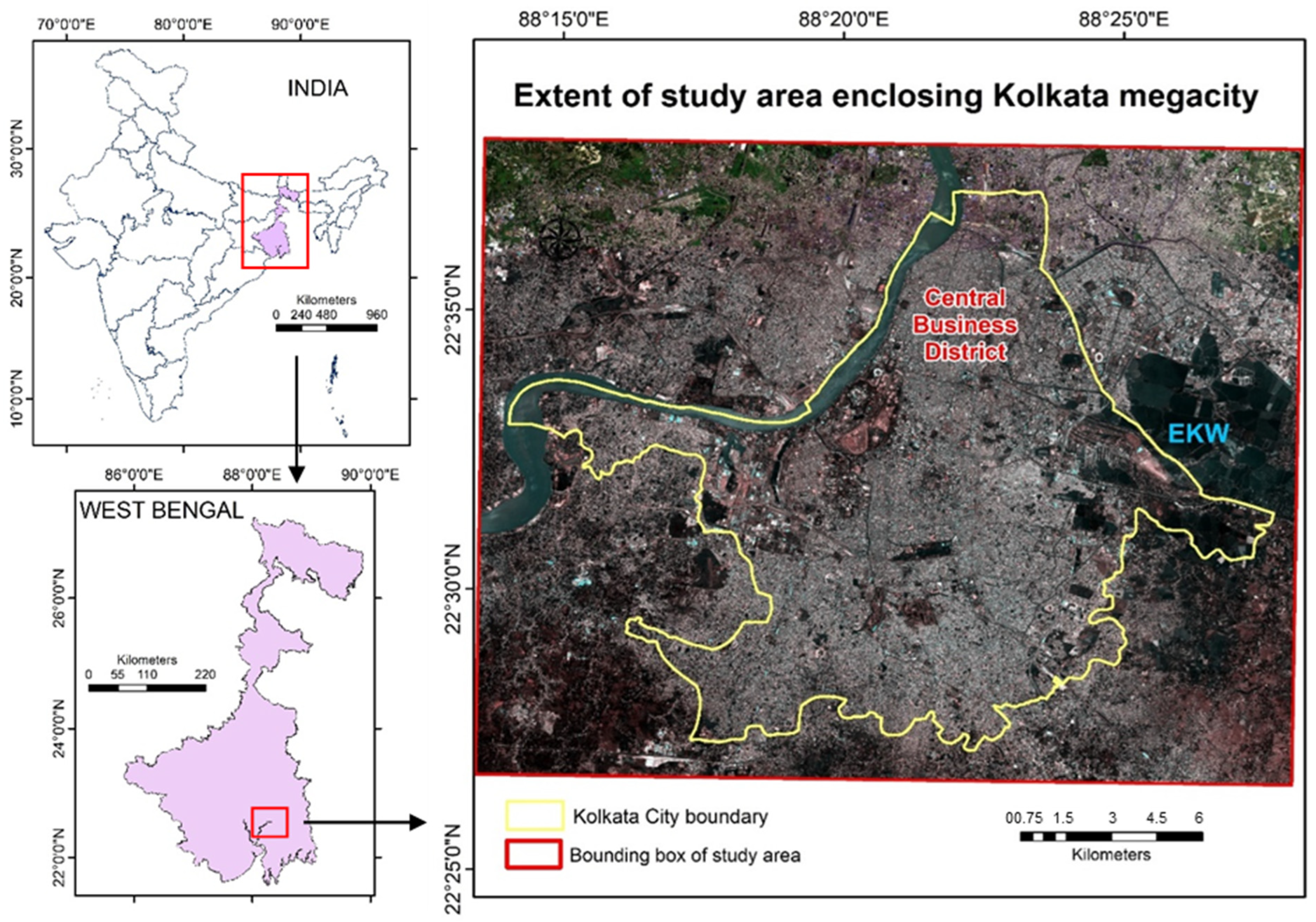






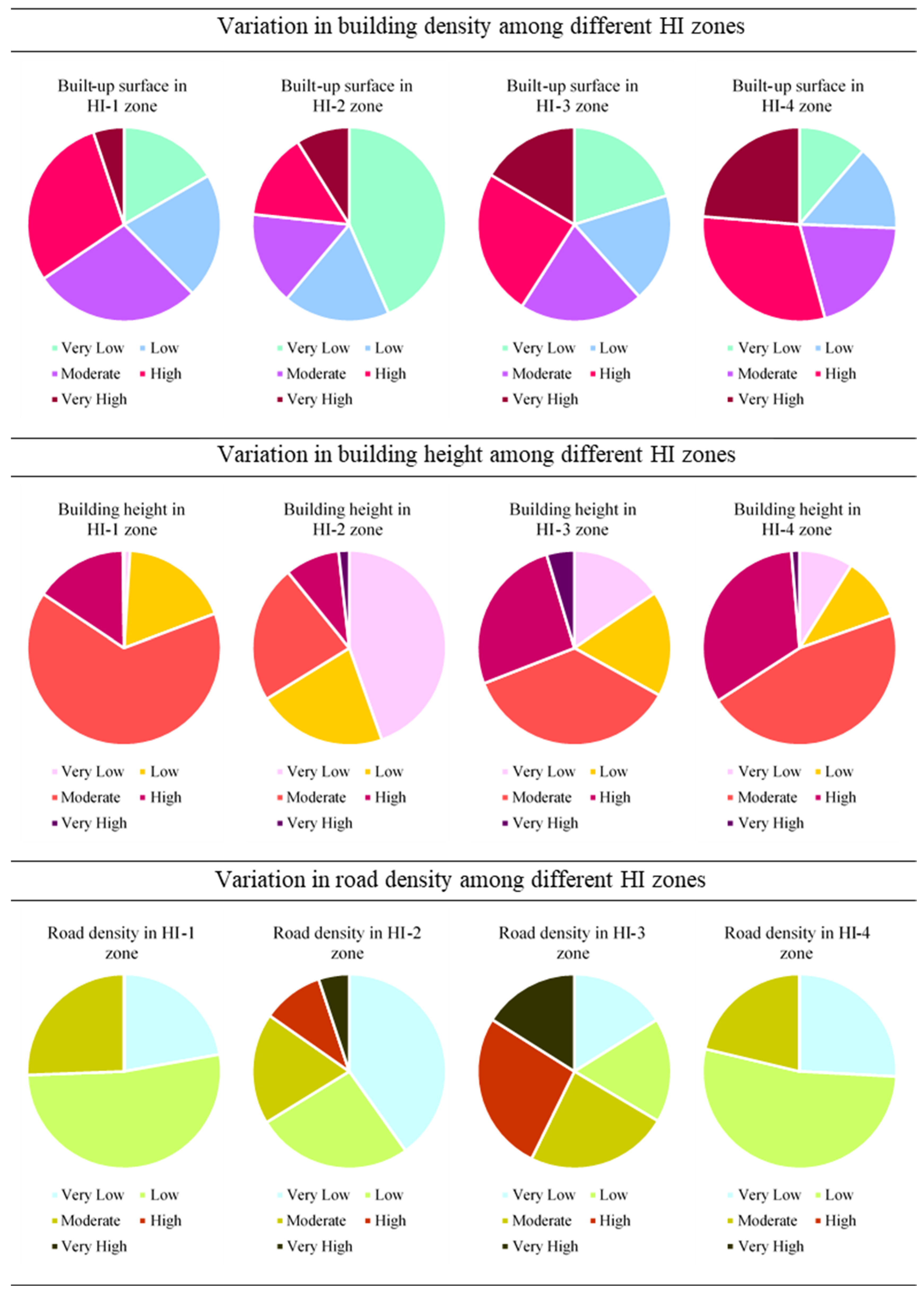


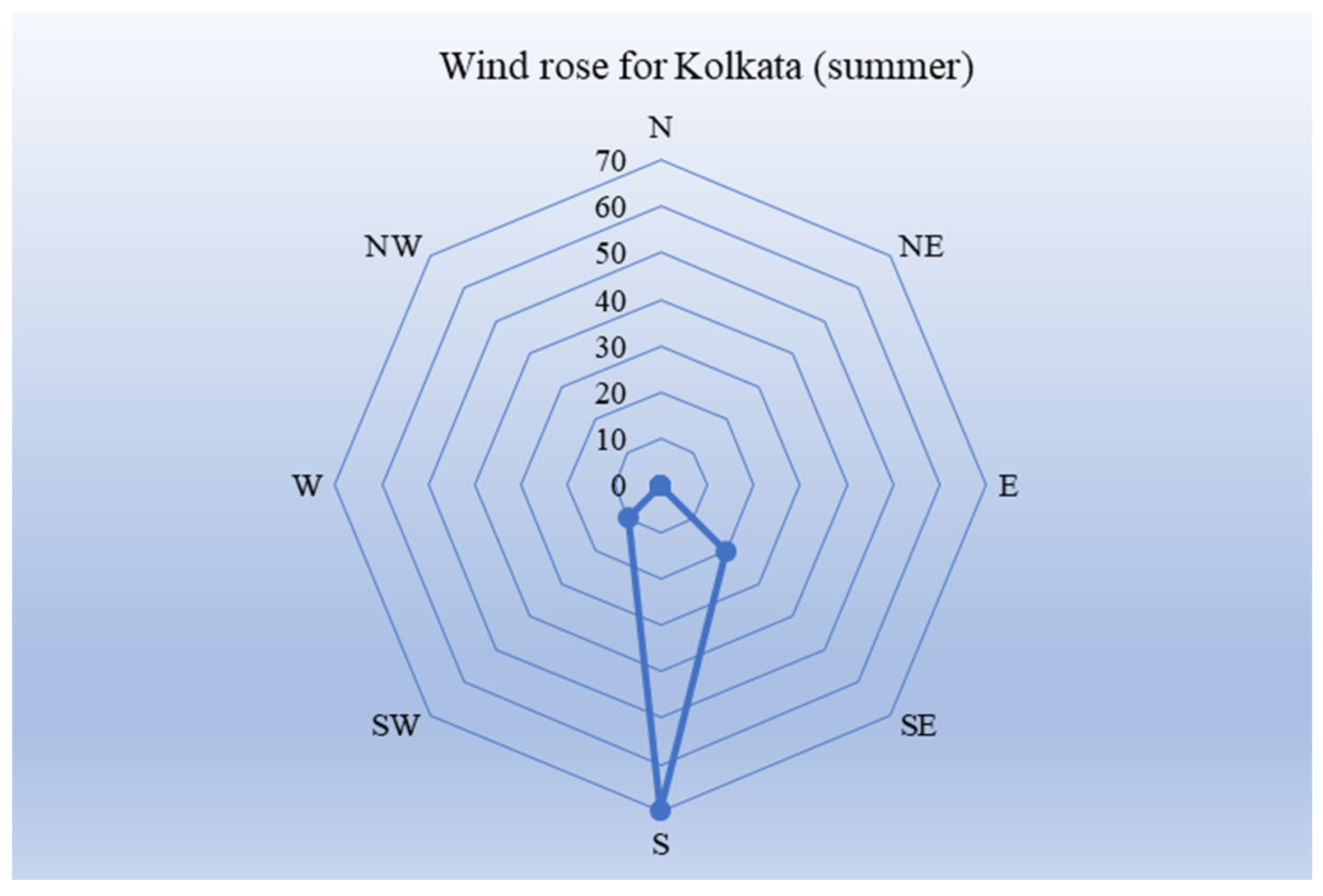
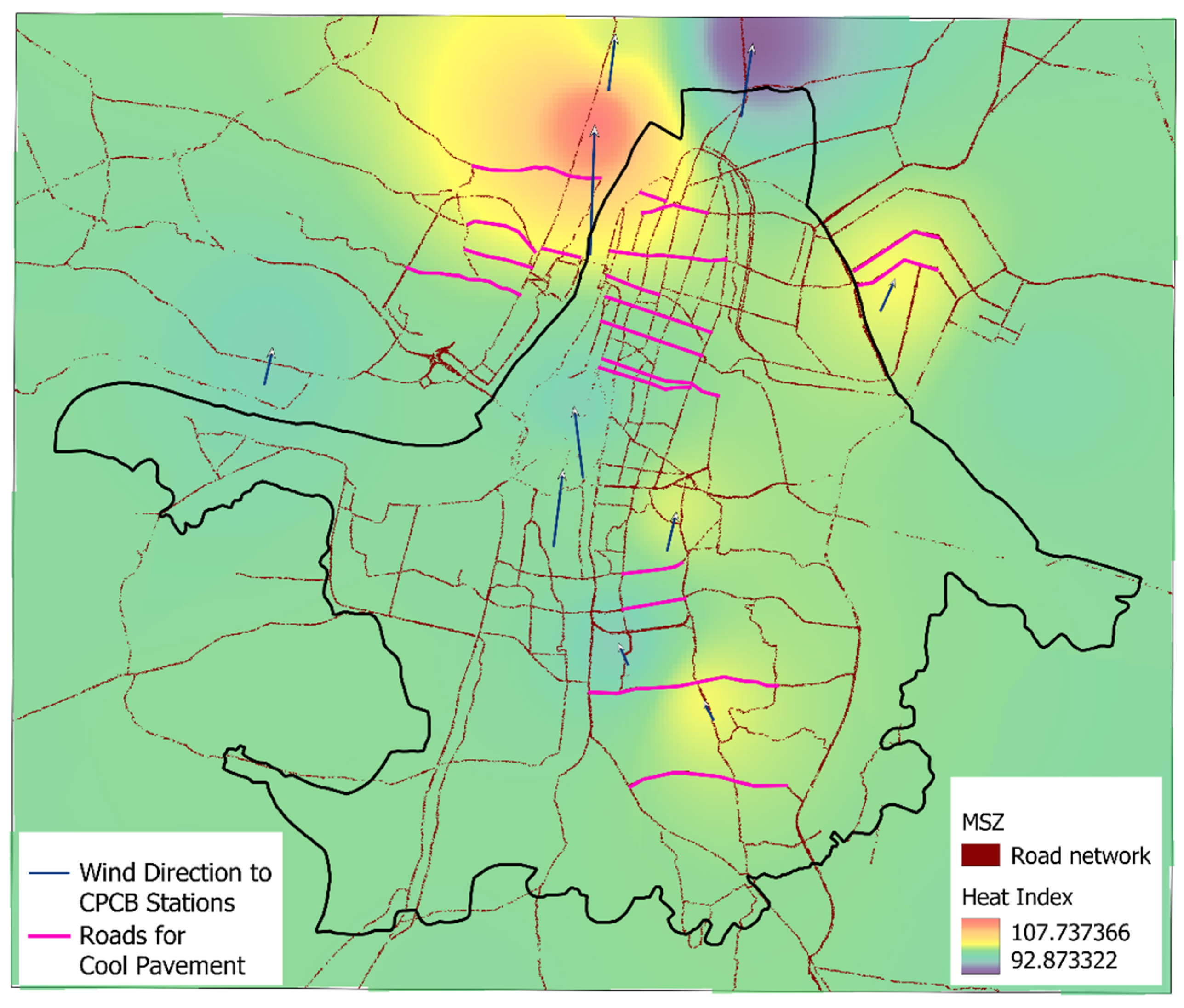
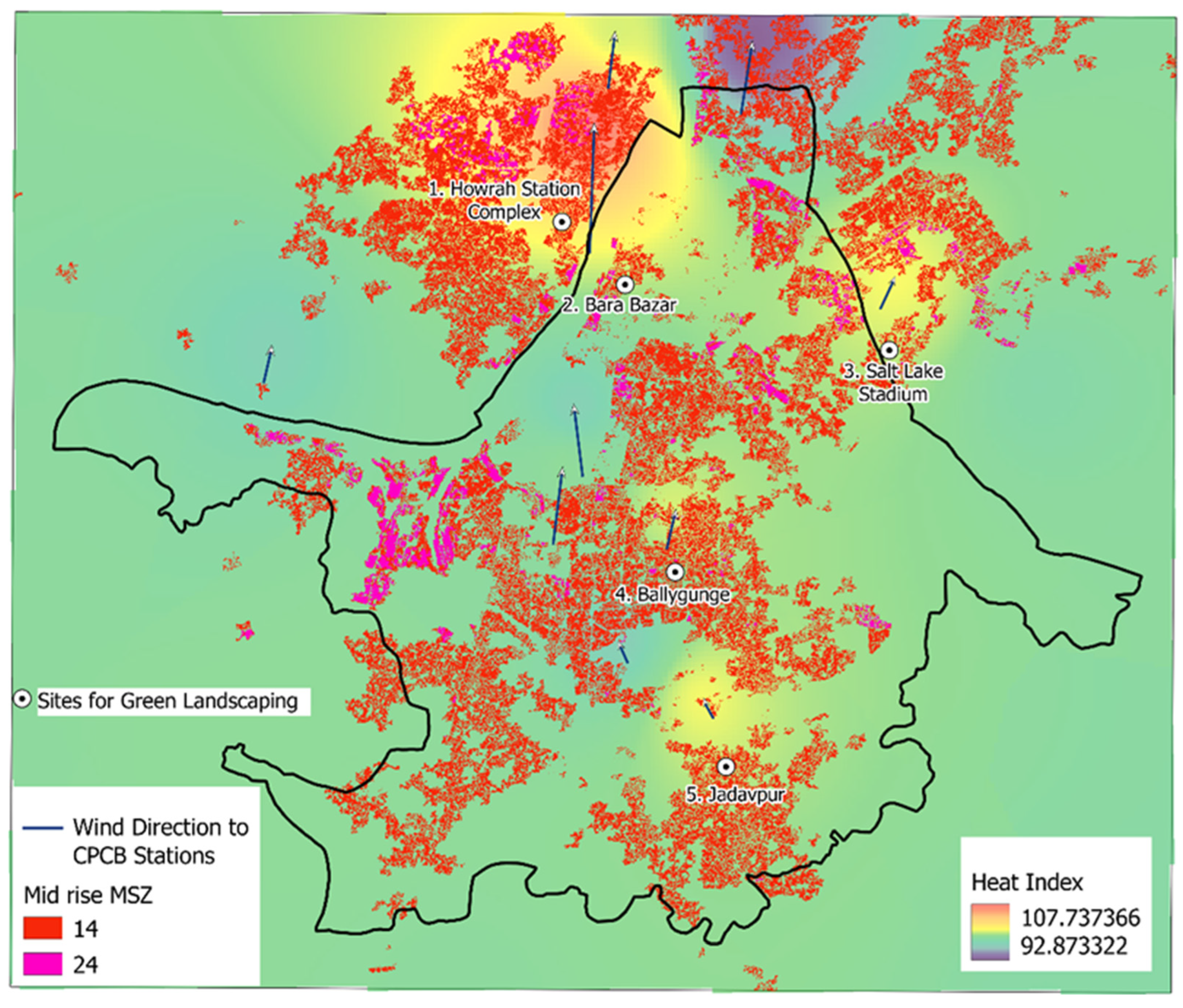
| Sl. No. | Class Characteristics | AT Values (°C) |
|---|---|---|
| 1 | No thermal stress | 9–26 |
| 2 | Moderate heat stress | 26–32 |
| 3 | Strong heat stress | 32–38 |
| 4 | Very strong heat stress | 38–46 |
| 5 | Extreme heat stress | >46 |
| Type | MSZ Name | Major Characteristic | Detailed Characteristics |
|---|---|---|---|
| Open spaces | MSZ 01 | Low vegetation surfaces | NDVI ≤ 0.3 |
| MSZ 02 | Medium vegetation surfaces | 0.3 < NDVI ≤ 0.5 | |
| MSZ 03 | High vegetation surfaces | NDVI > 0.5 | |
| MSZ 04 | Water surfaces | Land < 0.5 | |
| MSZ 05 | Road surfaces | ||
| Built spaces | MSZ 11 | Residential | Building height ≤ 3 m |
| MSZ 12 | Residential | 3 m < building height ≤ 6 m | |
| MSZ 13 | Residential | 6 m < building height ≤ 15 m | |
| MSZ 14 | Residential | 15 m < building height ≤ 30 m | |
| MSZ 15 | Residential | Building height > 30 m | |
| MSZ 21 | Non-residential | Building height ≤ 3 m | |
| MSZ 22 | Non-residential | 3 m < building height ≤ 6 m | |
| MSZ 23 | Non-residential | 6 m < building height ≤ 15 m | |
| MSZ 24 | Non-residential | 15 m < building height ≤ 30 m | |
| MSZ 25 | Non-residential | Building height > 30 m |
| Index | Thermal Discomfort Zones | Percent Area Cover | Resident Numbers in the Zone |
|---|---|---|---|
| HI | Hot | 99.01 | 12,087,885 |
| Very hot | 0.99 | 146,389 | |
| UTCI | Moderate heat stress | 98.58 | 12,027,521 |
| Strong heat stress | 1.42 | 206,753 | |
| WBDT | Elevated threat | 93.63 | 11,538,627 |
| Moderate threat | 6.37 | 695,647 |
Disclaimer/Publisher’s Note: The statements, opinions and data contained in all publications are solely those of the individual author(s) and contributor(s) and not of MDPI and/or the editor(s). MDPI and/or the editor(s) disclaim responsibility for any injury to people or property resulting from any ideas, methods, instructions or products referred to in the content. |
© 2024 by the authors. Licensee MDPI, Basel, Switzerland. This article is an open access article distributed under the terms and conditions of the Creative Commons Attribution (CC BY) license (https://creativecommons.org/licenses/by/4.0/).
Share and Cite
Gupta, A.; De, B.; Shukla, A.K.; Pignatta, G. Vulnerability Assessment of a Highly Populated Megacity to Ambient Thermal Stress. Sustainability 2024, 16, 3395. https://doi.org/10.3390/su16083395
Gupta A, De B, Shukla AK, Pignatta G. Vulnerability Assessment of a Highly Populated Megacity to Ambient Thermal Stress. Sustainability. 2024; 16(8):3395. https://doi.org/10.3390/su16083395
Chicago/Turabian StyleGupta, Aman, Bhaskar De, Anoop Kumar Shukla, and Gloria Pignatta. 2024. "Vulnerability Assessment of a Highly Populated Megacity to Ambient Thermal Stress" Sustainability 16, no. 8: 3395. https://doi.org/10.3390/su16083395
APA StyleGupta, A., De, B., Shukla, A. K., & Pignatta, G. (2024). Vulnerability Assessment of a Highly Populated Megacity to Ambient Thermal Stress. Sustainability, 16(8), 3395. https://doi.org/10.3390/su16083395








